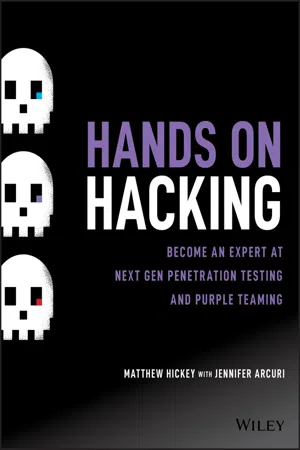
- English
- ePUB (mobile friendly)
- Available on iOS & Android
Hands on Hacking
About this book
A fast, hands-on introduction to offensive hacking techniques
Hands-On Hacking teaches readers to see through the eyes of their adversary and apply hacking techniques to better understand real-world risks to computer networks and data. Readers will benefit from the author's years of experience in the field hacking into computer networks and ultimately training others in the art of cyber-attacks. This book holds no punches and explains the tools, tactics and procedures used by ethical hackers and criminal crackers alike.
We will take you on a journey through a hacker's perspective when focused on the computer infrastructure of a target company, exploring how to access the servers and data. Once the information gathering stage is complete, you'll look for flaws and their known exploits—including tools developed by real-world government financed state-actors.
- An introduction to the same hacking techniques that malicious hackers will use against an organization
- Written by infosec experts with proven history of publishing vulnerabilities and highlighting security flaws
- Based on the tried and tested material used to train hackers all over the world in the art of breaching networks
- Covers the fundamental basics of how computer networks are inherently vulnerable to attack, teaching the student how to apply hacking skills to uncover vulnerabilities
We cover topics of breaching a company from the external network perimeter, hacking internal enterprise systems and web application vulnerabilities. Delving into the basics of exploitation with real-world practical examples, you won't find any hypothetical academic only attacks here. From start to finish this book will take the student through the steps necessary to breach an organization to improve its security.
Written by world-renowned cybersecurity experts and educators, Hands-On Hacking teaches entry-level professionals seeking to learn ethical hacking techniques. If you are looking to understand penetration testing and ethical hacking, this book takes you from basic methods to advanced techniques in a structured learning format.
Frequently asked questions
- Essential is ideal for learners and professionals who enjoy exploring a wide range of subjects. Access the Essential Library with 800,000+ trusted titles and best-sellers across business, personal growth, and the humanities. Includes unlimited reading time and Standard Read Aloud voice.
- Complete: Perfect for advanced learners and researchers needing full, unrestricted access. Unlock 1.4M+ books across hundreds of subjects, including academic and specialized titles. The Complete Plan also includes advanced features like Premium Read Aloud and Research Assistant.
Please note we cannot support devices running on iOS 13 and Android 7 or earlier. Learn more about using the app.
Information
Chapter 1
Hacking a Business Case
If you know the enemy and know yourself, you need not fear the results of a hundred battles. If you know yourself but not the enemy, for every victory gained you will also suffer a defeat. If you know neither the enemy nor yourself, you will succumb in every battle.Sun Tzu, The Art of War
All Computers Are Broken
- Whatsapp, an instant messaging application, was found to be vulnerable to an attack that would allow the attacker to take control of a victim's smartphone and negate the effects of Whatsapp's end-to-end encryption. This encryption allowed users to send private messages to one another (Whatsapp's greatest selling point).
- Security company Trend Micro had customer records stolen by its own employee. Those records were used to make scam calls to customers to defraud them. This case highlights the importance of internal security controls and not just the protection of public-facing services.
- Credit card provider Capital One had the personal details of more than 100 million customers stolen by a malicious hacker who supposedly exploited a misconfigured web application firewall—a technology designed to protect websites from attack! The stolen records consisted of names, physical addresses, Social Security numbers, and bank details. After the news hit in July 2019, Capital One projected attack-related costs of up to $150 million.
- In December 2019, UK company Travelex hit the headlines when it was affected by a ransomware attack. In a ransomware attack, attackers effectively steal data and demand a ransom for its return. The ransom in this case was $6 million, although it appears that Travelex was able to recover its data without paying the criminals. This cannot be said of all organizations and individuals that have been affected by ransomware.
The Stakes
What's Stolen and Why It's Valuable
The Internet of Vulnerable Things
Table of contents
- Cover
- Table of Contents
- Foreword
- Introduction
- Chapter 1: Hacking a Business Case
- Chapter 2: Hacking Ethically and Legally
- Chapter 3: Building Your Hack Box
- Chapter 4: Open Source Intelligence Gathering
- Chapter 5: The Domain Name System
- Chapter 6: Electronic Mail
- Chapter 7: The World Wide Web of Vulnerabilities
- Chapter 8: Virtual Private Networks
- Chapter 9: Files and File Sharing
- Chapter 10: UNIX
- Chapter 11: Databases
- Chapter 12: Web Applications
- Chapter 13: Microsoft Windows
- Chapter 14: Passwords
- Chapter 15: Writing Reports
- Index
- End User License Agreement